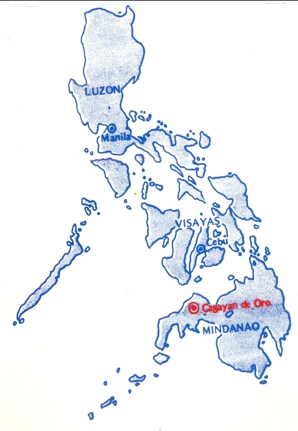Background of the Language
Profile
Cagayan de Oro (abbreviated C.D.O.) is one of the important cities in
Mindanao. It is the capital of the province of Misamis Oriental,
Philippines and the regional center for Northern Mindanao (Region X).
According to the 2000 census, it has an estimated population of 461,877
people in 200,000 households.
The city has many names, it is called the Gateway to Northern Mindanao,
the City of White Water Rafting and River Trekking. But most of all, it
is through its warm and hospitable people that the city got its name as
"The City of Golden Friendship".
Cagayan de Oro is base to multinational companies such as Del Monte
Philippines (formerly Philippine Packing Corporation). It has been
operating in Cagayan de Oro since the 1930's. Pineapples in nearby
Bukidnon Province are transported to their Processing Plant in Barangay
Bugo and shipped to the entire Philippines, Asia and the Pacific.
Cagayan de Oro City is the center of education in Northern Mindanao.
The city is the site of large state-run educational institutions and
universities.
Geography
It is located at 8°29′N 124°39′E, in Mindanao. It is bordered by the
province of Bukidnon to the east and south and by the municipality of
Manticao, Misamis Oriental to the west. On the north lies Macajalar Bay
in the Bohol Sea. The Cagayan River divides the city in the middle. The
river is crossed by four bridges in the city. The city is surrounded by
municipalites. The city is located in the province of Misamis Oriental
and Region X. The city is outside the typhoon belt, but it is affected
by the Inter-Tropical Convergence Zone. The city is bordered by Opol,
Tagoloan, and Bukidnon.
Accessibility
Cagayan de Oro, as the gateway to Northern Mindanao, is very
accessible. From Manila, it is an hour and fifteen minutes away by
plane and from Cebu it is an hour and ten minutes. The Lumbia Airport
caters daily flights to and from Manila and Cebu. Cagayan de Oro will
soon have the Laguindingan International Airport that will cater
international flights to South Korea and other parts of the world. By
sea, there are regular trips to Manila, Cebu, Tagbilaran, Jagna,
Bacolod, Dumaguete and Iloilo. By land, there are regular bus trips to
Gingoog, Davao, Butuan and Surigao in the CARAGA Region, Valencia and
Malaybalay in Bukidnon, Iligan, Ozamiz, and other parts of Mindanao.
Language
Majority of the people in Cagayan de Oro speak Cebuano (also called
Bisaya), although most residents understand Tagalog. The national
language of the Philippines is Filipino and all students in elementary
and high schools in CDO take classes in Filipino. Most government
employees and business people have good command of the English
language.
People from Cagayan de Oro are called Cagay-anons.
History
The area of present Cagayan de Oro has been occupied by indigenous
people for approximately 40,000 years. The first inhabitants were the
Higaunons, and later on, the Visayan groups.
Two thousand years ago, there were already ancient Kagayanons living
around the vicinity of the Huluga Caves. There were also ancient tools
used by the ancient Kagayanons. When the Arab missionaries came,
Kalambaguhan (or present Cagayan de Oro) was part of the sultanate of
Tagoloan. Kalambaguhan was a small settlement of Bukidnons who lived
along the riverbanks of Kalambaguhan River.
During this time, Sultan Kudarat would raid these places. Datu
Salangsang, their leader, led the Bukidnons to transfer to the hills of
Huluga. In 1622, Fray Agustin de San Pedro went to see Datu Salangsang
and to transfer to present day Gaston Park. The raids of the
Maguindanao warriors were repulsed by Fray Agustin de San Pedro.
Mindanao was divided into two districts. Cagayan de Misamis (or present
Cagayan de Oro) became the capital of the district. Pope Pius XII
created the first Catholic Archdiocese in Mindanao, which elevated the
Diocese of Cagayan. During the American Occupation, revolutionaries
fought with the Americans. However, the Americans gained victory.
During the Japanese Invasion in 1942, many houses were burned. In 1945,
Cagayan was liberated by the Americans.
It was from this settlement that the present Cagayan de Oro originated.
In 1845, a stone church was built on the site, which later became the
present San Agustin Metropolitan Cathedral. The Church was destroyed
during the American liberation in 1945. Later on, the church was
reconstructed through the efforts of Archbishop James T.G. Hayes,
Cagayan de Oro's first Archbishop.
Through the efforts of Congressman Emmanuel Pelaez, the town of Cagayan
de Misamis became a city on June 15, 1950 and its name changed to
Cagayan de Oro. Since then, Cagayan de Oro became one of the peaceful
and progressive cities in the whole archipelago.
Source:
http://www.visitmyphilippines.com/index.php?title=CagayandeOroCity&func=all&pid=1771&tbl=0
http://en.wikipedia.org/wiki/Cagayan_de_Oro_City
| Source |
Reported number of speakers |
Vitality Assessment
|
| www.ethnologue.com |
15,810,000
|
safe
|
| www.unesco.org/culture/languages-atlas/en/atlasmap.com |
0
|
safe
|
| www.endangeredlanguages.com |
0
|
safe
|
| www.wikipedia.com |
20,000,000
|
safe
|
| (other source) |
0
|
|
Your opinions about these findings and your own assessment here
back to top
|

